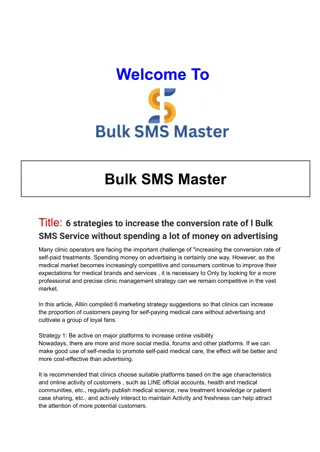Comparative Analysis of Aviation Safety Management Systems: MSG-3 vs. SMS
The aviation industry continuously strives to enhance safety, leading to the development of Safety Management Systems (SMS) by ICAO and the longstanding Maintenance Steering Group (MSG-3) program. These systems focus on improving safety through different approaches, with MSG-3 emphasizing engineering and maintenance technology, while SMS centers on organizational system safety. Despite their distinctiveness, both programs aim to enhance aviation safety through systemic approaches. A comparative analysis reveals parallels, areas for improvement, and the evolution of safety standards in aircraft design. Effective risk analysis processes within MSG-3 have been shown to yield high safety levels. This analysis highlights the importance of aligning safety practices with program goals to meet evolving industry needs.
Download Presentation

Please find below an Image/Link to download the presentation.
The content on the website is provided AS IS for your information and personal use only. It may not be sold, licensed, or shared on other websites without obtaining consent from the author.If you encounter any issues during the download, it is possible that the publisher has removed the file from their server.
You are allowed to download the files provided on this website for personal or commercial use, subject to the condition that they are used lawfully. All files are the property of their respective owners.
The content on the website is provided AS IS for your information and personal use only. It may not be sold, licensed, or shared on other websites without obtaining consent from the author.
E N D
Presentation Transcript
Aviation Safety Management Systems: A comparative analysis between Maintenance Steering group (MSG-3) and Safety Management Systems (SMS) LISA WHITTAKER COLLEGE OF AVIATION WESTERN MICHIGAN UNIVERSITY
Overview Overall, the aviation industry has an excellent safety record. Yet, there is always room for improvement. Recently, ICAO began the process to introduce a new industry-wide aviation program called Safety Management Systems (SMS) All 191 ICAO member states agree to abide by Standards and Recommended Procedures (SARPS), so that now includes SMS. All domains within aviation will be required to implement a program based on the SMS guidelines.
Overview The Maintenance Steering Group, MSG-3, is also an industry wide aviation safety program. It began decades ago, in 1968. The goal is also to improve safety. It has evolved over the years. It is mature program with well established processes and methodologies. MSG-3 is all about engineering and maintenance technology and SMS is more about organizational system safety. However, both programs address system safety in aviation operations.
Overview MSG-G is described. SMS is described. A comparison was conducted and is identified using the pillars that make up the SMS program. Significant parallels exist between these two major aviation safety methodologies. Challenges or gaps were identified. By focusing on the gaps, program leaders can apply best practices to fit the new safety program goals.
MSG-1, MSG-2, MSG-3 Evolution Evolution of safety in aircraft design Reactive Catastrophic failures response Proactive Safe Life -Replacing parts prior to failure Fail Safe - redundancy Prevention Advanced design - damage tolerance analysis through engineering modeling, extensive data collection and testing
MSG-3 Purpose To design airplanes with the highest possible level of reliability for safety and economic reasons. Empirical evidence shows that the risk analysis process used for MSG-3 yields higher safety levels.
MSG-3 Program The maintenance inspection program is developed by each manufacturer for model aircraft. Major airlines participate to develop the program based on their extensive expertise in maintenance. They have a large staff of engineers. Smaller airlines rely more heavily on the manufacturer.
MSG-3 Methodology The approach is task oriented. System failure modes are analyzed using a systematic method. Failure Modes and Effects Analysis (FMEA) This method is used to develop the initial maintenance schedule required of aircraft certification. It is beyond the scope of much of the hands-on maintenance world* It is often a multi-year process, involving the application of rigorous logic, the analysis of reams of data and the interaction of multiple administrative bodies. * key point in the gap analysis
MSG-3 Methodology The Group Method The analytical work is conducted by the Industry Steering Committee (ISG) working group. Manufacturer s engineers Airline subject matter experts Regulators The working groups present their results to the ISC for approval. The final output is the Maintenance Review Board Report (MRBR). The MRBR must be approved by the chair, a rep from the regulatory agency.
MSG-3 Data Collection In service reliability provides the crux of data used in the program. Determined by Mean Time Between Failures (MTSB) Failure reports come from the Service Difficulty Reports (SDRs). Failure data of systems, components and structures comes from airlines reports Mandatory Data reveals specific failure trends Analysis determines need for corrective action. The FAA regulates the SDR systems, NASA maintains the database. Reports are used by the FAA and other constituents for planning, directing, controlling and evaluating certain assigned safety related programs. Alerting of safety issues Supporting safety inspections and investigations for accidents and incidents Aviation safety /accident prevention programs
SMS Evolution Evolution of Safety Programs Reactive Preventive Predictive 1950s into 1970s Designing better airplanes 1970s to 1990s Human Factors focus Today Human error / Organizational perspective
The evolution of safety thinking TECHNICAL FACTORS HUMAN FACTORS TODAY ORGANIZATIONAL FACTORS 1950s 1970s 1990s 2000s Ref: ICAO SMM, 2013, p. 2.2 Fuente: James Reason
SMS Evolution Reason s model focuses on organizational factors. The foundation of SMS is organizational safety Enhancing overall safety in the most efficient manner requires the adoption of a system approach to safety management. Every segment and level of an organization must become part of a safety culture that promotes and practices risk reduction (ACRP, 2007) Ferguson&Nelson, 2014
SMS Purpose ICAO is spearheading the SMS initiative to assist in managing safety risks associated with the increase of air traffic within the next 15 years. All ICAO member states will have to comply with the SMS guidelines.
SMS Program and Methodology Program Methodology Specifically, the safety risk methodology is the creation of a proactive safety system that The safety management SARP is contained in Annex 19 for all domains of aviation. The plan lies within the pillars and elements that required specific planning and documentation of safety features. Identifies risks, including latent risks Analyzes the probability and severity of an accident or incident occurrence. Each member state is responsible for issuing and enforcing the program through new regulation.
SMS Personnel Personnel Safety personnel are required per the Safety Management Manual. An accountable executive. Key safety personnel reporting to the executive. Organizations can implement the program with a similar level of complexity as their organization. Large organizations already have established team of personnel who have authority and responsibility for safety. Medium size organizations can rely on the Director of Safety Small organizations may handle safety situations through ad hoc committees. Staffing the organization with personnel who are available and qualified to conduct SMS safety requirements is challenging.
SMS Data Collection Most aviation organization, aside from airlines, have little or no data collection systems for hazards or other system elements. Data collection and assessment is one of four pillars for SMS. As of 2015 (recently) SMS is required of airlines. The data required is different than SDRs. SMS required the hand-on maintenance and operations world to conduct assessments with rigorous logic, but without the benefit of reams of hazard or failure data. SMS safety issue reporting is not mandatory. Confidentiality is a concern. Risk of exposure for liability or violations. Web based systems SMS can use WBAT (Web-based Analysis Tool), also used for other FAA programs like ASAP (Aviation Safety Action Program). Software providers: SMSPro and Pro Digiq No aggregate data system for SMS
Comparison of MSG-3 and SMS Significant similarities and differences exist between MSG-3 and SMS. SMS is arranged in four pillars. Safety Policy SMS could benefit from implementing some of the best practices established by MSG-3. Safety Risk Management Safety Assurance Safety Promotion Both programs will be described within these pillars.
Comparison of MSG-3 and SMS Pillar 1: Safety Policy MSG-3 is conducted within interactive industry working groups and steering committees. The working groups are formally organized with managers, engineers, safety and reliability experts, certification, publications, marketing, product support personnel, along with key maintenance and engineers from the airlines. Working group members conduct the detailed analyses. SMS requires appointing a safety executive. Key safety personnel are appointed, including a safety manager as a focal point.
Comparison of MSG-3 and SMS Pillar 2: Safety Risk Management MSG-3 and SMS have common risk evaluation processes. MSG-3 uses Failure Modes and Effects Analysis SMS involves hazard identification and risk assessment. Both failures and hazards require a survey of systems. Any system component that could result in serious malfunction must be mitigated. Reason s model for safety management is a common thread for both programs. Even the statistical probability of failure of 1x10-9 is common
Comparison of MSG-3 and SMS Pillar 2: Safety Risk Management MSG-3 and SMS have differences. Data collection MSG-3 relies on the SDR (Service Difficulty Reports). They are abundant because they are required by the FAA. They are comprehensive because every failure in the airline industry must be reported. The data is aggregate providing an industry wide view of issues. SMS hazard and risk assessment is required. There is no existing database. Databases are being developed, but held within organizations and not shared industry wide. Personnel who report hazards and analyze risks are not established or experienced. Concern is expressed for exposing individual or company liability by sharing data.
Comparison of MSG-3 and SMS Pillar 3: Safety Assurance MSG-3 is well established. SDRs provide abundant reliability data. Data is managed industry wide, including oversight. Safety performance is monitored within industry working groups. SMS is in the development stage Performance monitoring is identified as Safety studies Audits Investigation Continuous improvement is required by both programs.
Comparison of MSG-3 and SMS Pillar 4: Safety Promotion MSG-3 Program participants come from all around the organization, Technical analyses are conducted by technical subject matter experts. SMS is in the training and promotion development stage Familiarization programs must be provided to all employees. Specific training must be provided for those responsible for analyses. Some organization may contract certain duties.
Gaps / Challenges Safety reporting For SMS, data collection has not been clearly defined, as in MSG-3. The Aviation Safety Reporting System is well established, but there is a history of reporting controversies within. The FAA supports the use of ASRS data in SMS. Just Culture is a current topic Flight safety is based on transparency and on the sharing of information. All feedback systems rely on each person s willingness to provide essential safety information, which often means being prepared to report one s own mistakes and errors. Safety Analysis Subject matter experts are needed for SMS Safety Risk Management. Training must begin in education and certification programs and be part of on-the-job training. Experiences must be shared throughout the segment of industry (airlines, airports, ATC, etc.) Common databases or aggregate data can be developed in emerging software programs..
Sharing Best Practices The structure for Safety Risk Management is well established for MSG-3. Safety depends on data Quantity and quality Philosophy and technology are key. SMS is an emerging initiative. Best practices can be adopted based on similar safety programs in the aviation. Organization by groups Information and data software systems Development of analytical expertise of personnel.























